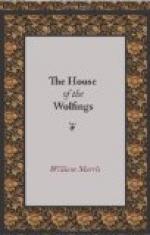Now the name of this House was the Wolfings, and they bore a Wolf on their banners, and their warriors were marked on the breast with the image of the Wolf, that they might be known for what they were if they fell in battle, and were stripped.
The house, that is to say the Roof, of the Wolfings of the Mid-mark stood on the topmost of the slope aforesaid with its back to the wild-wood and its face to the acres and the water. But you must know that in those days the men of one branch of kindred dwelt under one roof together, and had therein their place and dignity; nor were there many degrees amongst them as hath befallen afterwards, but all they of one blood were brethren and of equal dignity. Howbeit they had servants or thralls, men taken in battle, men of alien blood, though true it is that from time to time were some of such men taken into the House, and hailed as brethren of the blood.
Also (to make an end at once of these matters of kinship and affinity) the men of one House might not wed the women of their own House: to the Wolfing men all Wolfing women were as sisters: they must needs wed with the Hartings or the Elkings or the Bearings, or other such Houses of the Mark as were not so close akin to the blood of the Wolf; and this was a law that none dreamed of breaking. Thus then dwelt this Folk and such was their Custom.
As to the Roof of the Wolfings, it was a great hall and goodly, after the fashion of their folk and their day; not built of stone and lime, but framed of the goodliest trees of the wild-wood squared with the adze, and betwixt the framing filled with clay wattled with reeds. Long was that house, and at one end anigh the gable was the Man’s-door, not so high that a man might stand on the threshold and his helmcrest clear the lintel; for such was the custom, that a tall man must bow himself as he came into the hall; which custom maybe was a memory of the days of onslaught when the foemen were mostly wont to beset the hall; whereas in the days whereof the tale tells they drew out into the fields and fought unfenced; unless at whiles when the odds were over great, and then they drew their wains about them and were fenced by the wain-burg. At least it was from no niggardry that the door was made thus low, as might be seen by the fair and manifold carving of knots and dragons that was wrought above the lintel of the door for some three foot’s space. But a like door was there anigh the other gable-end, whereby the women entered, and it was called the Woman’s-door.
Near to the house on all sides except toward the wood were there many bowers and cots round about the penfolds and the byres: and these were booths for the stowage of wares, and for crafts and smithying that were unhandy to do in the house; and withal they were the dwelling-places of the thralls. And the lads and young men often abode there many days and were cherished there of the thralls that loved them, since at whiles they shunned the Great Roof that they might be the freer to come and go at their pleasure, and deal as they would. Thus was there a clustering on the slopes and bents betwixt the acres of the Wolfings and the wild-wood wherein dwelt the wolves.




